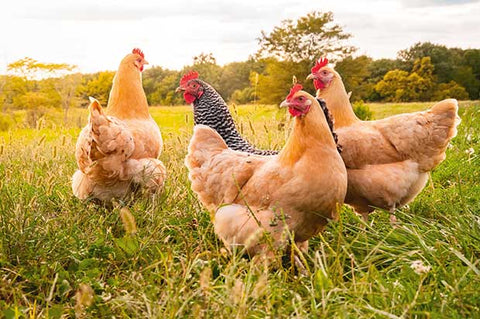1. Chickens are living descendants of dinosaurs
Chickens are the closest living relatives of dinosaurs! Scientific evidence has proven the shared common ancestry between chickens and the Tyrannosaurus rex.

2. Chickens aren’t completely flightless
Chickens were domesticated about 8000 years ago, and evolved from the Red junglefowl, which are tropical birds that live in the jungle. These wild birds fly to escape predators and to roost high up in trees. Today’s domestic chickens still have the ability to fly, although not as effectively. Chickens can fly for short distances – enough to clear obstacles or reach a perch.

3. Chickens can dream
Research has shown that chickens experience REM (rapid eye movement) while sleeping, meaning they can dream just like us! They also have a sleep phase that humans don’t experience called unihemispheric slow-wave sleep, where one half of the brain is asleep and the other is awake. This means that chickens can sleep with one eye open, which is especially useful for looking out for predators.

4. Chickens have better colour vision than humans
Like humans, chickens have colour vision, and are able to see red, green and blue light. However, what makes chicken vision unique from ours is that they are also able to see ultraviolet light, which are the colours you see when using a black light!

5. Chickens have complex communication
Chickens have over 30 unique vocalizations that they use to communicate a wide variety of messages to other chickens, including mating calls, stress signals, warnings of danger, how they are feeling and food discovery.

6. Chickens have great memories
Chickens are able to recognize over 100 different faces, even after being separated for extended periods of time, highlighting their long-term memory capabilities. These faces don’t just include chickens, they can recognize the faces of humans too!

7. Chickens bathe by covering themselves in dirt
While this may seem contradictory, the dirt is essential to helping chickens stay clean! Chickens have an oil gland on their back that is used to spread oil over their feathers to make them waterproof. Over time, the oil goes stale, and chickens need to wash the old oil off through dust bathing. Dust bathing is when chickens crouch on the ground and spread dirt or another dusty material over their body. The stale oil sticks onto the particles of dirt, and gets shaken off. Chickens can then spread fresh oil onto their feathers.

8. Chickens have a pecking order
Chickens live in groups called flocks. The social structure of these flocks depends on a hierarchy called a pecking order, which is an order of dominance. All chickens know their place in this order, and it helps to maintain a stable, cohesive group.

9. Egg shell colour can be determined by the hen’s earlobe
Ever wondered what causes the difference between brown and white eggs? It depends on the breed of the hen, but it’s not feather colour that tells you what colour the egg shell will be. It’s the colour of the hen’s earlobes! Generally, hens with red earlobes will lay brown eggs, and hens with white earlobes lay white eggs (with a few exceptions of course). Although the colour of the eggs may differ, the nutritional content or flavour does not.

10. Chickens are very intelligent animals
Studies have shown that chickens are self-aware and can distinguish themselves from others. They learn from one another, such as a chick learning from her mother which foods are good to eat. Chickens can also demonstrate complex problem-solving skills.





